 NRx (formerly known as Net Results Express) is UHN's monthly research e-newsletter. Every year, the December issue of NRx is dedicated to highlighting the previous year’s research achievements at UHN's five research institutes, the Princess Margaret Cancer Centre, the Toronto General Research Institute (TGRI), the Toronto Western Research Institute (TWRI), the Toronto Rehabilitation Institute (TRI) and the Techna Institute (Techna).
NRx (formerly known as Net Results Express) is UHN's monthly research e-newsletter. Every year, the December issue of NRx is dedicated to highlighting the previous year’s research achievements at UHN's five research institutes, the Princess Margaret Cancer Centre, the Toronto General Research Institute (TGRI), the Toronto Western Research Institute (TWRI), the Toronto Rehabilitation Institute (TRI) and the Techna Institute (Techna).
In this issue you can read about:
-
DISCOVERY—UHN researchers developed new treatments for hepatitis C and HIV infections and anorexia; and they shed further light on the mechanisms underlying cancer of the eye, diabetes and the resistance of certain blood cancers to chemotherapy.
-
PEOPLE—UHN welcomed Dr. Donald Weaver, a medicinal chemist and clinical neurologist, as the new Director of TWRI.
-
INFRASTRUCTURE—The Krembil Discovery Tower, UHN’s newest research space, and the Guided Therapeutics Operating Room (GTx OR) opened their doors.
-
SUPPORT—Funding from CFI and other organizations will enable UHN researchers to continue their groundbreaking research in the fields of cancer, epigenomics, diabetes and Alzheimer’s disease.
-
DISTINCTION—UHN scientists were honoured for their acheivements in research.
We hope you will find this newsletter informative and helpful. If you have feedback or questions, please contact www@uhnresearch.ca.
Happy holidays to all.
Christopher J. Paige, PhD, FCAHS
Vice President, Research
University Health Network
Respiration: Testing a New Model to Treat Lung Injury
Acute respiratory distress syndrome (ARDS) is a life-threatening condition in which the lungs are unable to adequately absorb oxygen and release carbon dioxide. A multicentre international clinical trial, led by TWRI’s Dr. Niall Ferguson, found that ARDS patients treated with a new ventilation technique known as high-frequency oscillatory ventilation (HFOV) fared less well than those treated with mechanical ventilation, the conventional supportive treatment for ARDS. Although mechanical ventilation is not an ideal treatment for ARDS, as it can damage lungs and compromise their function, the clinical trial suggests that it is still the best treatment option for ARDS. [Pubmed abstract]
Cardiology: Effect of Sleep Apnea on Heart Function.
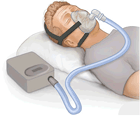
Continuous positive airway pressure therapy (above) has been shown to improve heart function in heart failure patients with OSA.
Many heart failure patients suffer from obstructive sleep apnea (OSA)—a disorder characterized by interrupted breathing during sleep because of a narrowing or blockage of the throat. In a sleep study involving 40 heart failure patients, TRI and TGRI’s Dr. Douglas Bradley and TGRI’s Dr. John Floras found that OSA events were associated with decreases in stroke volume—the amount of blood pumped by the left ventricle of the heart in one contraction and an important indicator of heart function. The findings of this study highlight the need to improve cardiac function in heart failure patients by treating sleep apnea. [Pubmed abstract].
Obesity: The Role of Intestinal Bacteria in Fatty Liver Disease

Weight loss and increased physical activity are currently the primary management regimens for non-alcoholic steatohepatitis.
Non-alcoholic fatty liver disease (NALF) caused by obesity is the most common form of fatty liver disease in Canada. TGRI’s Johane Allard showed that a relationship exists between non-alcoholic steatohepatitis, a severe form of NALF, and a lower level of the gut bacteria Bacteroidetes. These findings suggest that targeting these microbes represents a new potential therapy to treat NALF. [Pubmed abstract]
Neuroscience: Treating Anorexia with Deep Brain Stimulation
In a world first, a team of UHN scientists led by TWRI’s Dr. Andres Lozano, demonstrated that deep brain stimulation (DBS), a treatment that stimulates specific regions of a patient's brain, helps treat anorexia. Anorexic patients starve themselves because of a distorted body image and an overwhelming fear of gaining weight. DBS helped patients achieve and maintain improvements in body weight, mood and anxiety. [Pubmed abstract].
Cancer: The Causes of Tumours of the Eye.

The newly discovered tumour types are generally larger than the inherited variety.
Retinoblastoma, a cancer of the eye, develops because of a mutation to the retinoblastoma 1 (RB1) gene—a gene that normally prevents the formation of cancer—that is typically inherited from parents. The Princess Margaret Cancer Centre’s Dr. Brenda Gallie led a multicentre study that analyzed more than 1000 retinoblastoma tumours excised from people with no family history of the disease and discovered a new cancer-promoting gene responsible for driving the growth of these tumours. This discovery will enable doctors to better adapt a patient’s treatment to their tumour. [Pubmed abstract]
Rehabilitation: Referral Strategies for Women with Heart Disease
Heart disease is the leading cause of death in women around the world. Cardiac rehabilitation (CR) is known to reduce death rates among these patients and improve their quality of life. Despite these benefits, women are less likely to be referred to CR than men. TRI and TGRI’s Dr. Sherry Grace examined the different strategies used by Ontario hospitals to refer women to CR and found that the combination of automatic and personal discussion-based referral strategies resulted in the greatest CR enrolment rates among women—10 times greater than the current method of referral. [Pubmed abstract]
Liver Disease: A New Approach in the Treatment of Hepatitis C
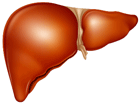
The hepatitis C virus primarily infects the liver (above).
Approximately 170 million people worldwide are chronically infected with the hepatitis C virus (HCV), a major cause of liver cirrhosis, liver failure and liver cancer. A clinical trial led by TGRI’s Dr. Harry Janssen, through his position at the Erasmus Medical Center University Hospital in Holland, demonstrated the safe and effective use of a new drug called miravirsen to treat HCV. It works by blocking microRNA-122, a molecule that is important for the replication of HCV in the liver. This study is the first ever to demonstrate that blocking microRNA can be used as a treatment option in humans. [Pubmed abstract]
Diabetes: Resistance to Glucagon in the Brain
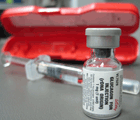
Glucagon is currently used as an emergency treatment of severe diabetic hypoglycemia, which is associated with low blood glucose levels.
Glucagon is a small protein that plays a crucial role in modulating blood sugar levels. TGRI’s Dr. Tony Lam discovered that glucagon binds to specific cells in the hypothalamus, a region of the brain that controls many processes including hunger, to modify sugar production in the liver and sugar levels in the blood. Dr. Lam’s team also demonstrated that this mechanism of regulation is impaired in an experimental model of diabetes and obesity. These findings suggest that glucagon signalling in the brain could be a new therapeutic target to treat diabetes. [Pubmed abstract]
Epilepsy: Brain Signal Variability Predicts Memory Performance
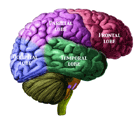
The temporal lobe of the human brain (green) contains structures like the hippocampus, which are essential for memory storage.
TWRI’s Dr. Mary Pat McAndrews and former postdoctoral fellow Dr. Andrea Protzner (now at the University of Calgary) demonstrated that patterns in the activity of the brain of people with epilepsy can be linked to the brain’s ability to accomplish certain tasks. By studying the activity in a region of the brain that includes the hippocampus—a structure implicated in memory formation—they could predict a patient’s ability to acquire and retrieve memories, regardless of the kind of memory. [Pubmed abstract]
Stroke: Brains from Brawn
TRI’s Dr. Dina Brooks, who is also a Professor in the Department of Physical Therapy at the University of Toronto and a Senior Scientist at West Park HealthCare Centre, and PhD student Susan Marzolini led a study showing that exercise and an increase in muscle mass improve mental function in patients who have suffered a stroke. After six months of aerobic and resistance training, stroke patients showed significant improvements in concentration, visual thinking, planning skills and verbal reasoning. These studies show that exercise is an important component of stroke rehabilitation. [Pubmed abstract]
Stem Cells: Pulling at Heartstrings with Biowire

Earlier this year, TGRI’s Dr. Sara Nunes de Vasconcelos published a new method describing the use of a “biowire” for growing a personalized heart patch made from a patient’s own cells. In this approach, immature heart cells are exposed to physical, mechanical and electrical cues that mimic the environment in a developing heart, coaxing them to grow into healthy heart cells that can beat in unison and can be paced using electrical cues. Biowire technology is a promising discovery that brings scientists one step closer to culturing personalized heart cells for therapeutic purposes. [Pubmed abstract]
Cancer: Understanding BRCA1 in Breast Cancer
An altered form of a gene called BRCA1 is found in 5-10% of breast cancers. The Princess Margaret Cancer Centre’s Drs. Tak Mak and Mona Gauthier shed further light on the function of BRCA1 and its role in cancer development. The researchers found that the BRCA1 protein and estrogen play an important role in stabilizing Nrf2, a protein that helps to protect a cell’s DNA against mutations. The altered form of the BRCA1 protein fails to stabilize Nrf2, leading to the accumulation of DNA mutations that drive tumour growth. This new understanding of BRCA1's role could help guide breast cancer treatment strategies. [Pubmed abstract]
Cancer: Why Some Treatments May Fail
A team led by the Princess Margaret Cancer Centre’s Dr. Vuk Stambolic discovered that cells lacking a protein known as PTEN are more susceptible to cell death if they are treated with a combination of a DNA-damaging agent and an inhibitor of another protein, PI3K. Interestingly, when cells lacking PTEN are treated with a DNA-damaging agent alone, they become more prone to developing alterations in their genome, which could cause cancer cells to grow faster or become more resistant to therapies. These results suggest that PTEN status should be taken into consideration when determining the most effective therapeutic strategy to treat a particular cancer. [Pubmed abstract]
Stem Cells: New Role for GATA-3 in Self-renewal
Hematopoietic stem cells (HSCs) are immature cells that can be coaxed along different paths of development, to produce all types of cells found in our blood, including white and red bloods cells. When some HSCs divide, they give rise to cells identical to themselves—a process known as self-renewal. The Princess Margaret Cancer Centre’s Dr. Norman Iscove provided new evidence that a protein known as GATA-3 plays an important role in the self-renewal of HSCs. These findings may be useful in developing techniques to increase the number of HSCs for use in bone marrow transplantation—a procedure that replenishes the blood cells of leukemia patients after chemotherapy. [Pubmed abstract]
Medical Imaging: Modeling Blood Flow in Tumours

A phantom is a cylinder with pumps and tubes that control the flow of simulated blood and material.
Dynamic contrast-enhanced (DCE) computed tomography (CT) is an imaging technique that enables scientists to study blood flow in tissues in a non-invasive manner. Using a phantom—a device that mimics blood flow in a tumour—Techna’s Dr. Catherine Coolens has developed and tested mathematical models to extract clinically relevant information related to blood flow in tumours from DCE-CT scans. These models will improve our understanding of how blood vessels distribute drugs and nutrients in a tumour. [Pubmed abstract]
Cancer: The Root Cause of Multiple Myeloma Relapse
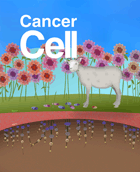
The discovery was featured on the cover of Cancer Cell.
Multiple myeloma (MM) is an incurable cancer of the bone marrow that persistently recurs after initial treatment. The Princess Margaret Cancer Centre’s Dr. Rodger Tiedemann and his team demonstrated that a small fraction of immature MM cells are not sensitive to conventional MM therapy. Subsequently, these MM cells mature and multiply to reboot the disease process, even in patients who appear to be in complete remission. Dr. Tiedemann’s results show that to cure MM, new drug targets must be identified. [Pubmed abstract]
Neurological Disorders: Unarrested Development.
A number of neurological disorders, including Rett syndrome, X-linked mental retardation and Angelmann syndrome are associated with genetic mutations that compromise the function of a gene known as Methyl-CpG-binding protein 2 (MeCP2). Using a mouse model of Rett syndrome, TWRI’s Drs. James Eubanks and Liang Zhang found that restoring MeCP2 function led to significant improvements in lifespan, behaviour and nervous system function. These results suggest that MeCP2 is a promising therapeutic target for the treatment of Rett and related syndromes. [Pubmed abstract]
Neuroscience: Wandering Away from Pain

Humans spend half their time on thoughts not associated with their immediate environment.
TWRI’s Dr. Karen Davis showed that when individuals experience pain, some people focus their attention on the pain while others drift away in thought. When patients avoid thinking about their pain, she observed an increase of activity in the default mode network (DMN), regions of the brain implicated in mind wandering, and strong interactions between the DMN and periaqueductal gray (PAG), a region of the brain that suppresses pain. These findings provide important clues as to why some individuals cannot disengage from pain and how others control their pain through cognitive-behavioural therapy. [Pubmed abstract]
HIV: A Powerful New Treatment

Shortly before publication of this study, dolutegravir received approval from Health Canada for the treatment of HIV infection in Canada.
An international clinical trial led by TGRI’s Dr. Sharon Walmsley demonstrated that a novel drug combination—a new drug called dolutegravir mixed together with abacavir-lamivudine—is a more effective treatment for HIV infection than the currently prescribed treatment. The dolutegravir combination therapy offered patients several advantages over conventional treatment: it lowered HIV levels in more patients in a faster time frame; it caused fewer side effects; and there was no evidence that the virus was becoming resistant to the new treatment. [Pubmed abstract]
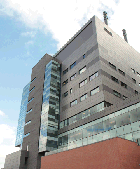
UHN's newest research and clinical facility—the Krembil Discovery Tower (KDT)—officially opened on November 20, 2013. The tower is a nine-story open-concept, state-of-the-art research facility. KDT will be occupied by research teams working in a variety of areas including neuroscience, medicinal chemistry, vision sciences, arthritis and immunity.
KDT was made possible through donations from the Krembil family, charities and the Toronto General & Western Hospital Foundation, as well as support from the Canada Foundation for Innovation (CFI), UHN and the Ontario government.
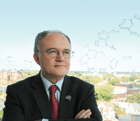
On July 2013, Dr. Donald Weaver was appointed as the new TWRI Director. Dr. Weaver is a practicing neurologist with a sub-specialty interest in epilepsy and dementia and is a trained medicinal chemist. His research focuses on the application of computer-assisted drug design in discovery and development of novel therapeutics for neurological disorders.

This past year, UHN-led projects captured infrastructure support for the cancer and diabetes research programs. The Centre for Cancer Epigenomics received $3.3M from CFI and an additional $3.3M from the Ontario Ministry of Research and Innovation. This project will create a cutting-edge sequencing and informatics facility that will examine the epigenomic basis of cancer for the advancement of personalized cancer medicine.
The Diabetes Discovery Core, which will use state-of-the-art equipment to examine the role of metabolism, inflammation and other cellular stress in beta cells and other metabolic tissues implicated in diabetes, also received funding from CFI.

TGRI’s Dr. Marcelo Cypel received a Tier 2 Canada Research Chair in Lung Transplantation, Dr. Jason Fish was awarded a Tier 2 Canada Research Chair in Vascular Cell and Molecular Biology and Dr. Minna Woo was granted a Tier 2 Canada Research Chair in Signal Transduction in Diabetes Pathogenesis. Additionally, TGRI’s Dr. Ren-Ke Li had his Tier 1 Canada Research Chair in Cardiac Regeneration renewed.
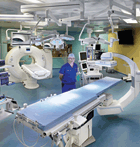
The Guided Therapeutics Operating Room (GTx OR) opened earlier this year, providing UHN with a dedicated research OR. This advanced OR is designed to advance the application of novel surgical guidance devices in a real world setting. It will be used to assess new surgical guidance prototypes for effectiveness and allow them to be safely integrated into surgical workflows.
UHN was named Canada’s top-funded research hospital in Research Infosource’s Top 40 Research Hospitals in Canada List 2013. The annual study examined research hospitals across the country and ranked them according to research income. UHN led the nation in research income with $302,304,000 for the fiscal year of 2012, an increase of almost 20% from the previous year.
TWRI Director Dr. Donald Weaver and his micropharma company, Treventis Corp., were awarded a $4.7M Seeding Drug Discovery Award from the Wellcome Trust. This funding will allow Dr. Weaver and Treventis to discover and develop disease-modifying small molecule drugs for Alzheimer’s and other protein misfolding diseases.

Research in epigenomics received a large financial boost from the Canadian Institutes of Health Research in partnership with Genome British Columbia, Fonds de recherche du Québec-Santé and the Japan Science & Technology Agency. These funds will support collaborative multinational research projects led by the Princess Margaret Cancer Centre’s Drs. Cheryl Arrowsmith, John Dick and partners in Japan.
The Ontario Institute for Cancer Research has pledged $52M in funding to support translational research that aims to improve the entire spectrum of cancer care, from prevention and early diagnosis, to diagnosis and treatment. Successfully funded projects include the Princess Margaret Cancer Centre’s Dr. Robert Rottapel's "Innovation in Target Validation Program" and Dr. John Dick’s “Cancer Cell Program”. The projects aim to develop more effective personalized cancer therapies.
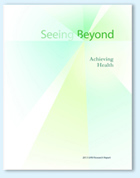
This year’s report focuses on how UHN’s clinicians, scientists, staff and Foundations work together to see beyond current limitations, to push the boundaries of scientific knowledge and to strive toward new possibilities. All of this is done to achieve one goal: to improve health.
The 2013 Research Report comprises 56 pages highlighting UHN’s achievements and selected news stories from the past year. To download this year’s report, click here.


 Dr.
Dr.  The Canadian Cancer Society named Dr.
The Canadian Cancer Society named Dr.  Dr.
Dr.  Dr.
Dr.  Dr.
Dr.  Dr.
Dr.  Dr.
Dr.  Dr.
Dr.  Dr. Andres Lozano received the Margolese National Brain Disorders Prize from the University of British Columbia. This prize is given to Canadians in recognition of outstanding contributions to the treatment, amelioration or cure of brain disorders.
Dr. Andres Lozano received the Margolese National Brain Disorders Prize from the University of British Columbia. This prize is given to Canadians in recognition of outstanding contributions to the treatment, amelioration or cure of brain disorders. Dr. Karen Davis was named as a Fellow of The Mayday Pain & Society Fellowship by the Mayday Fund.
Dr. Karen Davis was named as a Fellow of The Mayday Pain & Society Fellowship by the Mayday Fund.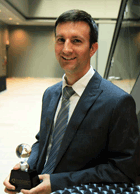 Dr. Thomas Purdie was presented with UHN’s 2012 Inventor of the Year Award which is given to a UHN researcher that has made outstanding and inventive contributions to patient-oriented biomedical research by developing technologies with commercialization potential. Dr. Purdie received the award for his role in developing software that has significantly improved the way cancer radiation therapy is delivered.
Dr. Thomas Purdie was presented with UHN’s 2012 Inventor of the Year Award which is given to a UHN researcher that has made outstanding and inventive contributions to patient-oriented biomedical research by developing technologies with commercialization potential. Dr. Purdie received the award for his role in developing software that has significantly improved the way cancer radiation therapy is delivered.